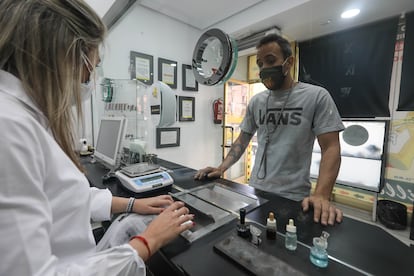Selling the jewelry: the last resort of cash-strapped Spaniards
The coronavirus crisis has forced customers back to cash-for-gold stores at a time when the precious metal has hit a price of $1,800 an ounce, the highest since 2012


“Hi. Can you tell me if this earring is made of gold? I want see if it’s worth enough to buy some milk and bread…”
This is not the first time that Daniel Rodríguez has sold gold, but he has never before been in a situation where he has had no alternative. A 35-year-old from Madrid, Rodríguez’s family has not had any income for three months due to the coronavirus crisis, resorting instead to help from the San Juan de Mata parish in Alcorcón to feed his three children, aged 14, 10 and two. The money from his ex-girlfriend’s earring will be helpful, he says while keeping one eye on his puppy waiting obediently at the door. “There are six mouths to feed in the family,” he notes.
On the other side of the shop’s bulletproof glass, Nerea Sánchez assesses the value of the earring. “It’s worth €23,” she says, to which Rodríguez replies, “Yes, that will do.”
Rodríguez is one of dozens of clients who come in here every day to sell jewelry. Many of them keep an eye on the price of gold, which exceeded $1,800 per ounce on Friday, the highest spike since 2012.
The buying and selling of gold came to a standstill during the coronavirus lockdown. Then, in Phase 0 of the national deescalation plan, several regional governments allowed these establishments to deal with clients by appointment. But in La Milla de Oro in Alcorcón, one of 79 such shops in the Compro Oro chain in Spain and Portugal, business began to boom from May 4, with the start of the deescalation. Since then, the average number of customers has risen steadily and now stands at 15 to 20 per day, which compares to pre-crisis figures. What is different, however, is the kind of client who walks through the door.
These are families with no income, young people who have lost their jobs, or people who are starting to receive their inheritance and prefer it in cashNerea Sánchez, La Milla de Oro
“Many of them are selling gold as a last resort,” says Sánchez. “These are families with no income, young people who have lost their jobs, or people who are starting to receive their inheritance and prefer it in cash. There is no specific profile just now, whereas before this, most of them were regular clients – mainly older people.”
Alba Roldán, who teaches economic history at the University of Barcelona, expects more people to be selling in the coming weeks, creating a far bigger “surge” than the one that came after the 2008 crisis. “People sell according to economic instability and difficulty, and we are facing the most uncertain time of all in contemporary history,” she says. When the last peak occurred, gold was going for $1,900 per ounce (€1,622).
“It’s a good time to buy gold,” explains Victor Morillo, head of the gold investment sales department at Oro Express in downtown Madrid. The first transaction he made on the first Monday of July was with a regular client wanting to buy 120 gold bars weighing 250 grams each. “This man had bought before, but with the growth [in the market] these days, he is making investments this big.” As part of one of the four main distributors in Spain, this store has multiplied its gold bar sales by 10. Meanwhile, Fernando Illanes, who runs Compro Oro, predicts further growth. “There are also a lot of new small investors coming in who prefer to have their savings in metal,” he says.
Although it may seem odd to be buying when the price is high, Prosper Lamothe, a professor of financial economics at Madrid’s Autonomous University, stresses the importance of gold as a port in a storm. “The price fluctuates but it is always rising,” he says. “Most likely it will rise even more in the following days and then stabilize. Gold has given a good return in the long term and will continue to do so.”
Pawnshops, a viable alternative
The network of pawnbrokers run by the Montemadrid Foundation has reverted to normal in terms of client figures, though not in terms of cycles. From May 11 – the day it reopened – until the first fortnight of June, there were 3,306 formalized deals, barely 100 less than during the same period in the previous financial year. However, Santiago Gil, director of Monte de Piedad in Madrid, believes we are living through disconcerting times, triggering “client psychosis.”
“Before the crisis, transactions were based on salaries,” he says. “Customers would take back their jewelry when they got paid at the end of the month. These days there is no set pattern. Some take it back because they have managed to save, and others come to pawn it because they have not received their furlough money for months. After the summer, when the temporary layoffs become permanent, we will definitely be able to talk about peaks and troughs.”
English version by Heather Galloway.









































